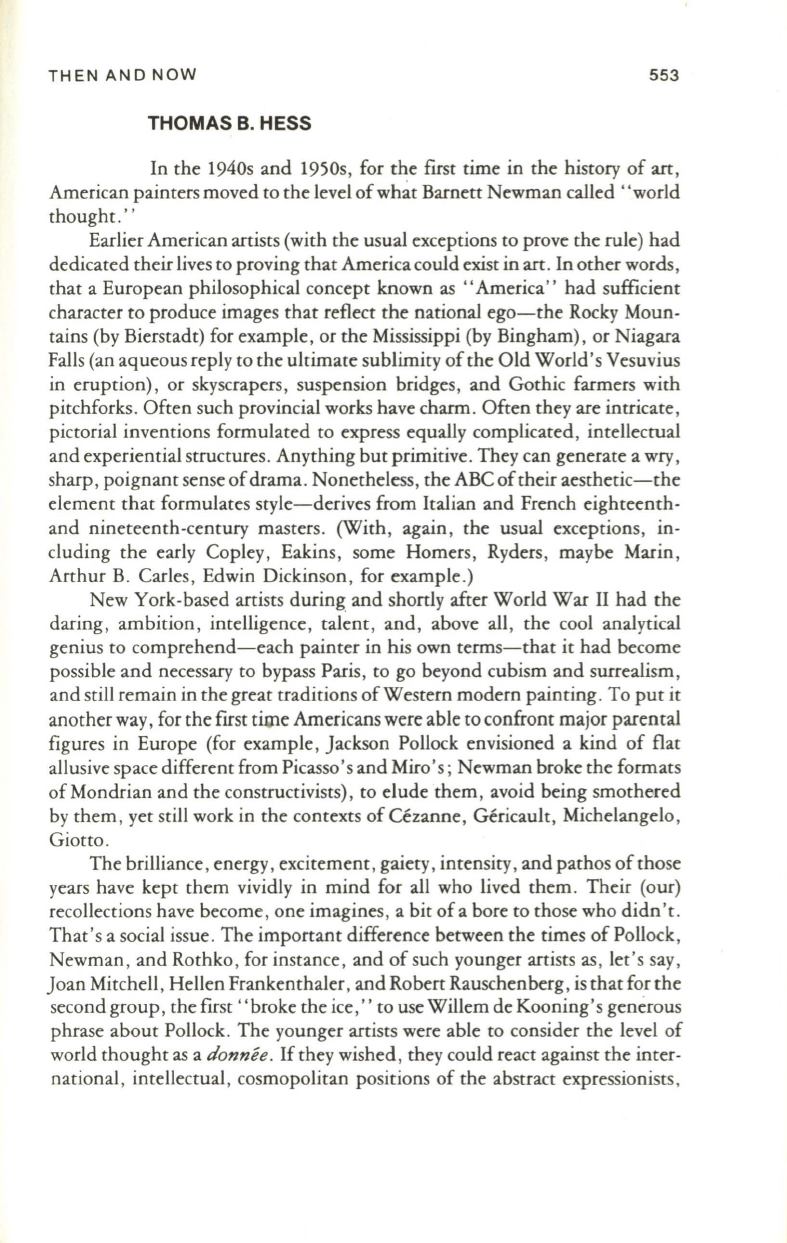
THEN AND NOW
553
THOMAS B. HESS
In the 1940s and 1950s, for the first time in the history of art,
American painters moved to the level of
wh~t
Barnett Newman called' 'world
thought."
Earlier American artists (with the usual exceptions to prove the rule) had
dedicated their lives to proving that America could
exist
in art. In other words,
that a European philosophical concept known as "America" had sufficient
character to produce images that reflect the national ego-the Rocky Moun–
tains (by Bierstadt) for example, or the Mississippi (by Bingham), or Niagara
Falls (an aqueous reply to the ultimate sublimity of the Old World's Vesuvius
in eruption), or skyscrapers, suspension bridges, and Gothic farmers with
pitchforks. Often such provincial works have charm. Often they are intricate,
pictorial inventions formulated to express equally complicated, intellectual
and experiential structures . Anything but primitive. They can generate a wry,
sharp, poignant sense ofdrama. Nonetheless, the ABC of their aesthetic-the
element that formulates style-derives from Italian and French eighteenth–
and nineteenth-century masters. (With, again, the usual exceptions, in–
cluding the early Copley, Eakins,
some
Homers, Ryders, maybe Marin,
Arthur B. Carles, Edwin Dickinson, for example .)
New York-based artists during and shortly after World War II had the
daring , ambition, intelligence ,
tal~nt,
and, above all, the cool analytical
genius to comprehend-each painter in his own terms-that it had become
possible and necessary to bypass Paris, to go beyond cubism and surrealism,
and still remain in the great traditions ofWestern modern painting. To put it
another way, for the first time Americans were able to confront major parental
figures in Europe (for example, Jackson Pollock envisioned a kind of flat
allusive space different from Picasso's and Miro's; Newman broke the formats
of Mondrian and the constructivists), to elude them, avoid being smothored
by them ,
yet
still work in the contexts of Cezanne, Gericault, Michelangelo,
Giotto .
The brilliance, energy, excitement, gaiety, intensity, and pathos of those
years have kept them vividly in mind for all who lived them. Their (our)
recollections have become, one imagines, a bit of a bore to those who didn't.
That 's a social issue. The important difference between the times of Pollock,
Newman , and Rothko, for instance, and of such younger artists as, let's say,
Joan Mitchell, Hellen Frankenthaler, and Robert Rauschenberg, is that for the
second group, the first' 'broke the ice," to
use
Willem de Kooning's generous
phrase about Pollock. The younger artists were able to consider the level of
world thought as a
donnie .
If they wished, they could react against the inter–
national , intellectual, cosmopolitan positions of the abstract expressionists,


